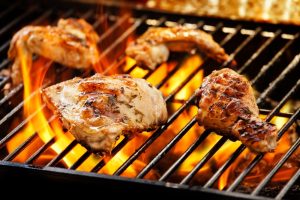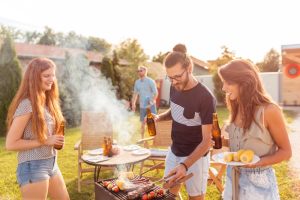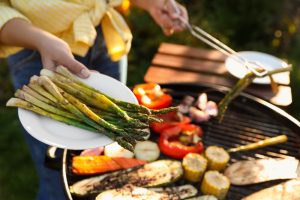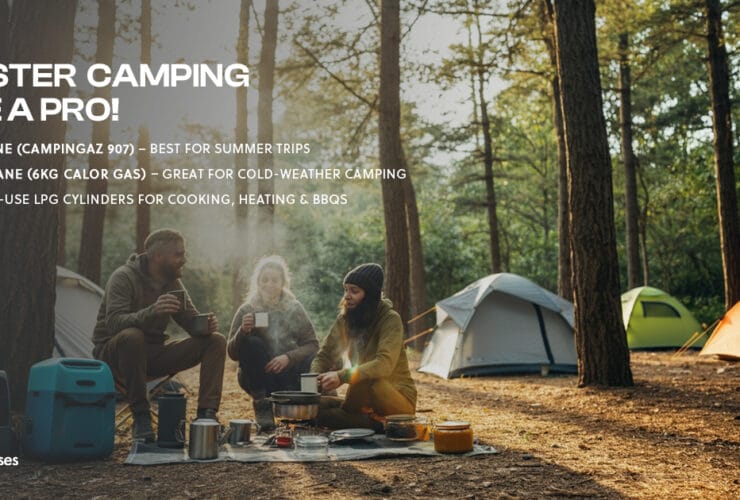Elevate Your BBQ Game With Bottled Gas
Barbecuing is an art form that requires skill, precision, and the right tools. One of the most essential components of a successful BBQ is the fuel you use. While charcoal grills have their merits, bottled gas, specifically propane and butane, offers a convenient and efficient alternative.
In this blog post, we will explore the differences between propane and butane for BBQ, the safe storage of gas, how to arrange the grill according to the food, and share some valuable tips and tricks for grilling with gas. At Bottle Gases, we are experts in working with BBQ gas bottles, and will be able to help you find the right fit for you.
Propane vs. Butane for BBQs
When choosing between propane gas bottles and butane gas for your BBQ, both gases have their advantages and considerations. Here’s a breakdown of their characteristics:
Propane
Propane is a popular choice for BBQs due to its high energy content and resourcefulness. Some of the key features that propane gas has are:
- High heat output. Propane offers excellent heat output, allowing for fast and efficient cooking. It reaches higher temperatures quickly, making it ideal for cooking on the BBQ, and can tackle any cut of meat, even steaks.
- Wintry weather performance. This gas performs well even in cold temperatures, making it a reliable choice for year-round grilling. So, if you fancy a mid-autumn BBQ, propane will be your best friend.
- We have an extensive range of propane gas available at Bottle Gases. You can find our cylinders in assorted sizes, so whether you’re looking for a 13kg propane gas bottle for camping trips or a 47kg propane gas bottle for BBQs, we offer you what you need.
Butane
Butane is another choice for bottled gas, often used for portable grills and BBQs. Let’s look at its features:
- Butane is commonly used in smaller, portable grills due to its compact and lightweight nature. It’s perfect for picnics, camping trips and BBQs.
- Lower boiling point. This gas has a lower boiling point than propane, making it more suitable for warm weather and mild climates.
- Availability. Butane may not be as readily available as propane, so it’s essential to check the availability before opting for this fuel.
If you want more information on the differences between propane and butane, why not read our blog ‘Propane Vs Butane – Which Is Best for Various Uses?’
Safely Storing Gas When Not in Use
Safety should be a top priority when handling bottled gas. We’ve listed out some of the most essential guidelines for storing gas when it is not being used:
Store in a Well-Ventilated Area
Gas cylinders should be stored outdoors or in a well-ventilated space, away from flammable materials or other heat sources. Adequate ventilation helps disperse any potential gas leaks and prevents the accumulation of flammable vapours.
Keep Upright and Secure
Ensure the gas cylinders are stored upright and properly secured to prevent tipping or accidents. You can use a sturdy, purpose-built cylinder rack or simply keep them stable on an even surface outdoors.
Valve Protection
Before storing your gas cylinders, you must close the cylinder valves tightly. This prevents gas leaks and reduces the risk of any accidental ignition. You can also use a protective valve cap to provide an extra layer of protection.
Regular Inspections
Regularly inspect your gas cylinders for any signs of damage, corrosion, or wear. You can do this by looking for dents, rust, or other abnormalities affecting the cylinder’s integrity. If you notice any issues, such as leaks or faults, we can help. At Bottle Gases, we have a returns policy that allows you to return any faulty products. We’ll meet the cost of the return and replace or exchange any products. We’ll also refund you the price paid, and this includes the delivery charge.
Store Away from Children
Keep gas cylinders out of reach of children and educate them about the potential hazards of gas. You can use barriers or fencing to prevent tampering or accidental access.
How to Arrange the Grill
Properly arranging the grill according to the type of food you’re cooking is essential if you want to achieve the best results. It might seem trivial, but the arrangement ensures that each item is cooked to absolute perfection.

We’ve gathered a few tips on the best ways to arrange the grill based on the type of food:
Direct Heat Method
The direct heat method involves placing the food directly over the flames. This is ideal for foods that require high heat and quick cooking, such as steaks, burgers, and other thick cuts of meat.
- For even cooking, arrange the food in a single layer, leaving space between each item to promote air circulation.
- Place thicker cuts closer to the hotter part of the grill to ensure they receive enough heat to cook evenly.
- Flip the food halfway through the cooking time to ensure even browning and prevent charring.
Indirect Heat Method
The indirect heat method involves cooking food next to, rather than directly over, the flames. This is suitable for larger cuts of meat or foods that require longer cooking time or gentle heat, such as whole chicken or ribs.
- Create two heat zones on the grill by turning on only one side of the burners or by stacking the charcoal on one side of the grill.
- Place the food on the side of the grill with no direct flame beneath it. This allows for slow, indirect cooking, preventing the food from burning or drying out.
- Close the lid to keep heat and create an oven-like environment for consistent cooking.
- Rotate the food occasionally to ensure even cooking and avoid hot spots.
Two-Zone Cooking
Two-zone cooking involves creating distinct hot and cool zones on the grill, allowing you to cook several types of food simultaneously.
- Divide the grill into two heat zones by turning on one side of the burners or arranging the charcoal accordingly.
- Place foods that require higher heat or searing, like steaks or burgers, directly over the hot zone.
- Place foods that require gentler heat, like vegetables or delicate fish on the cool zone.
We have a blog on some our gas BBQ tips and recipes if you are looking for a place to start.
Be BBQ Ready!
By embracing bottled gas, you can elevate your BBQ game to new heights. At Bottle Gas, we stock a wide range of BBQ and patio gas bottles suitable for domestic and commercial use. If you want to buy your gas from one of the leading suppliers and distributors of Calor Gas in the UK, contact us today.
Get ready to impress your family and friends with perfectly grilled meals that will have them coming back for seconds.




